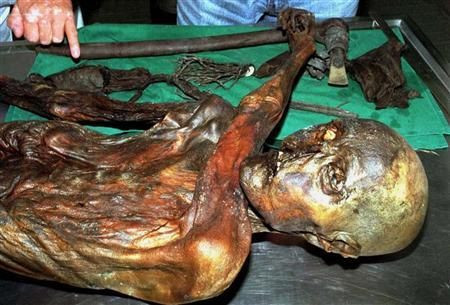Ötzi The Iceman, Europe’s Oldest Mummy, Suffered Head Blow Before Death 5,300 Years Ago

Ötzi the Iceman, Europe’s oldest mummy, was most likely the victim of an ambush before he died some 5,300 years ago. According to a new study published in the June issue of “Cellular and Molecular Life Sciences,” scientists now believe that Ötzi was killed by an “artery-piercing arrow” while he was eating a meal.
The study, which was conducted by a research team from the European Academy of Bolzano/Bozen, or EURAC, successfully analyzed Ötzi’s brain tissue, Live Science reports. As a result of the new data, scientists say that they were able to piece together a larger narrative about how he died and who he was. Back in 2012, scientists had already deduced that Ötzi was 45 at the time of his death and that he was most likely a farmer.
A new protein analysis of his brain tissue has also confirmed his tissue had blotted blood cells, a finding which supports scientists’ theory that Ötzi suffered a head injury before his death. Researchers said that they were also able to identify some of the brain proteins and blood cell proteins in the sample by using new protein analysis techniques aided by a computer-controlled endoscope. Researchers also uncovered evidence of an abundance of proteins involved in healing wounds and responding to stress.
While the new study hasn’t solved the riddle of whether Ötzi was killed by the arrow or a severe beating to his skull, scientists said that their findings were significant, nonetheless. They also ascertained that he suffered from heart disease, gum disease (periodontitis), tooth decay and probably Lyme disease.
"Investigating mummified tissue can be very frustrating," Frank Maixner, a microbiologist and co-author of the study, said in a news release. "The samples are often damaged or contaminated and do not necessarily yield results, even after several attempts and using a variety of investigative methods.
"When you think that we have succeeded in identifying actual tissue changes in a human who lived over 5,000 years ago, you can begin to understand how pleased we are as scientists that we persisted with our research after many unsuccessful attempts," Maixner said. "It has definitely proved worthwhile."
Ötzi’s frozen body was discovered in a glacier in the Alps in 1991 by a pair of German hikers, Erika and Helmut Simon, who were vacationing in the area. The Simons came across Ötzi in a gully bed, initially mistaking him for a piece of garbage. It wasn’t until they approached his body to get a better look that they realized they had stumbled upon a human corpse. Even then, the Simons had no idea how extraordinary their find was, imagining that Ötzi had perhaps fallen victim to a climbing accident a few years prior.
© Copyright IBTimes 2024. All rights reserved.





















